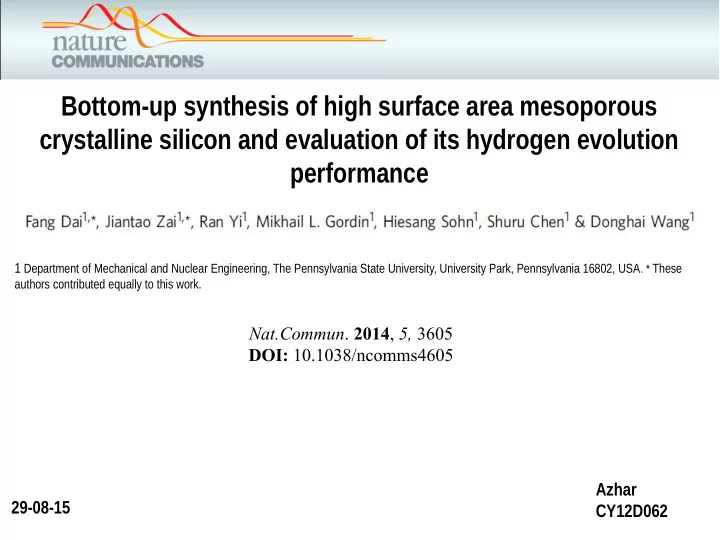

Bottom-up synthesis of high surface area mesoporous crystalline silicon and evaluation of its hydrogen evolution performance 1 Department of Mechanical and Nuclear Engineering, The Pennsylvania State University, University Park, Pennsylvania 16802, USA . * These authors contributed equally to this work. Nat.Commun . 2014 , 5, 3605 DOI: 10.1038/ncomms4605 Azhar 29-08-15 CY12D062
Introduction : • Porous Si has been deeply investigated in optoelectronics and sensors owing to its light-emitting properties,drug/gene delivery research, bio-compatibility, Li-ion battery anode. • Porous Si is also considered a promising candidate for hydrogen-generating materials because of its chemical and photocatalytic/photoelectrochemical reactivities towards water. • Conventional preparation techniques for porous silicon suffer from high mass loss because In this paper: of their etching nature. • They have demonstrate a bottom-up synthesis of mesoporous crystalline silicon materials with high surface area and tunable primary particle/pore size via a self-templating pore formation process. • These nanosized crystalline particles with high surface areas have high photocatalytic hydrogen evolution rate and extended working life. 2
Experimental section: Water wash Raw product Precusor Reduction mPSi Heat treatment SiCl4 KCl Amorphous silicon Crystalline silicon Salt byproducts NaCl Intermediate product Figure 1: Scheme of the synthesis route of mPSi. 3
Results: e Figure 2: Characterization of the intermediate products 4
Results: Figure 4: Characterization of mPSi materials. (a) HRTEM images of XRD patterns. (b) Nitrogen sorption isotherms and mPSi 600, 700 and BJH pore size distributions (inset). (c) XPS spectra. 800 (d) Raman spectra. 5
6
Photocatalytic hydrogen evolution of mPSi Figure 3: Optical properties and photocatalytic performance. (a–c) Optical band gaps and ultraviolet–visible diffuse reflectance spectra (inset) of mPSi materials. (d) Typical reaction time course of the photocatalytic H2 evolution of different unloaded porous Si materials and Si nanopowder under 300W xenon light.1
Discussion: • The preparation of mPSi is composed of two key processes, which are reduction and heat treatment. • In the first step, salts and Si are generated by the reduction of SiCl4 and precipitate out owing to their poor solubility in toluene solvent. • In the following heat treatment, the salts act as a pore filler to support the structure. • After heat treatment, the salts can easily be removed by water, which makes the synthesis less complicated than other templating methods • The mPSi materials possess several traits that make them attractive for photocatalytic H2 generation. 8
Conclusion: In conclusion, a bottom-up synthesis of mPSi materials was developed. This low-cost process is facile and efficient, and allows tuning of properties such as the surface area, pore size and primary particle size. Excellent chemical H2 generation rate can be obtained because of the high surface areas, nanopores and crystallity. 9
Complete magnesiothermic reduction reaction of vertically aligned mesoporous silica channels to form pure silicon nanoparticles 6500 C 2 Mg (g) + SiO2 (s) 2MgO (s) + Si (s) H=-564.42 kJ/mol 2 Mg (g) + Si (s) Mg2Si (s) H=-318.92 kJ/mol In this paper they have developed a procedure involving magnesium promoted reduction of vertically oriented mesoporous silica channels on reduced graphene oxides (rGO) sheets. Utilizing this approach, highly uniform, ca. 10 nm sized silicon nanoparticles are generated Fig 1: Schematic diagram of the fabrication process without contamination by unreacted silica. This new method for complete magnesiothermic reduction of mesoporous silica approach provides a foundation for the rational design of silicon structures. Fig 2: Proposed mechanism for complete reduction process Kim, K. H.; Lee, D. J.; Cho, K. M.; Kim, S. J.; Park, J.K.; Jung, H.T. Sci. Rep. 2015 , 5 , 9014.
Thermoresponsive and Photoluminescent Hybrid Silicon Nanoparticles by Surface-Initiated Group Transfer Polymerization of Diethyl Vinylphosphonate In this paper a method has been developed to combine the functional features of poly(diethyl vinylphosphonate) ( PDEVP ) and photoluminescent silicon nanocrystals . The polymer–particle hybrids were synthesized in three steps through surface initiated group transfer polymerization using Cp2YCH2TMS - (thf) as a catalyst. This pathway of particle modification renders the nanoparticle surface stable against oxidation. Kehrle, J.; Hohlein, I. M. D.; Yang, Z.; Jochem, A.R.; Helbich, T.; Kraus, T.; Veinot, J. G. C.; Rieger, B. Angew. Chem. 2014 , 126 , 12702−12705. 11
Solution Synthesis and Optical Properties of Transition-Metal-Doped Silicon Nanocrystals In this paper, they have synthesised transition metal (Mn, Ni, and Cu) doped Si NCs with controllable size and dopant composition. Optical properties of the doped and undoped Si NCs were studied using absorption and PL spectroscopy. Doped Si NCs demonstrated unique dopant-dependent optical properties compared to undoped Si NCs such as enhanced subgap absorption, and 40 nm shifts in the emission . This study represents the first general approach to synthesize a range of transition-metal-doped Si NCs. Benjamin, F. P.; Justinas, B.; Jonathan, E. H.; Justin, M. H.; Richard D. T. J. Phys. Chem. Lett. 2015 , 6 , 1573−1576
Future view: Plan for the experiments is very important. All these experiments are sensitive and have to be handled very carefully. Several possibility exists. Possible candidate for other applications, such as optoelectronics, drug delivery systems and even Li-ion batteries. 13
Recommend
More recommend